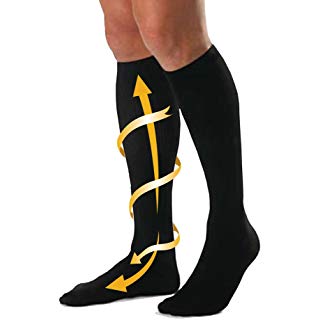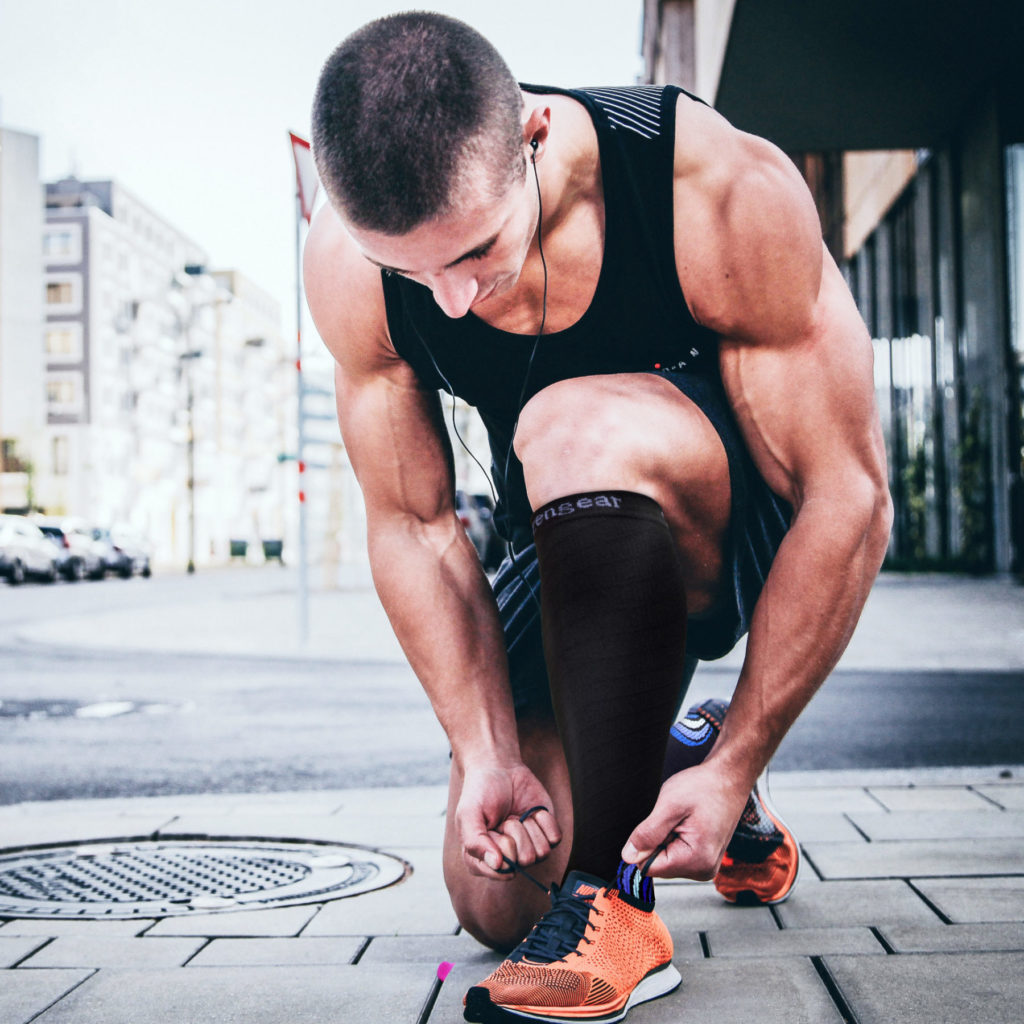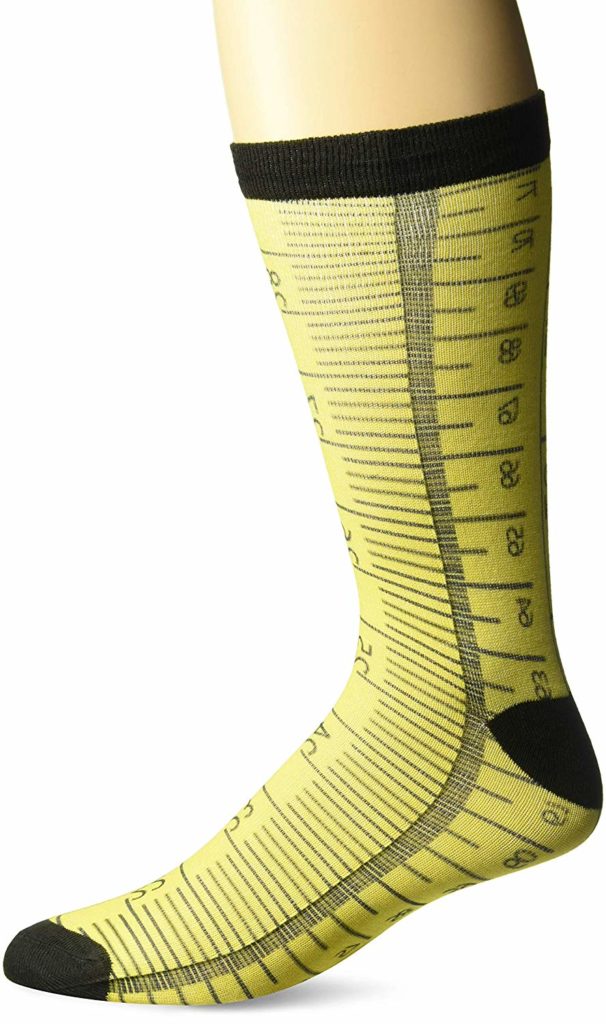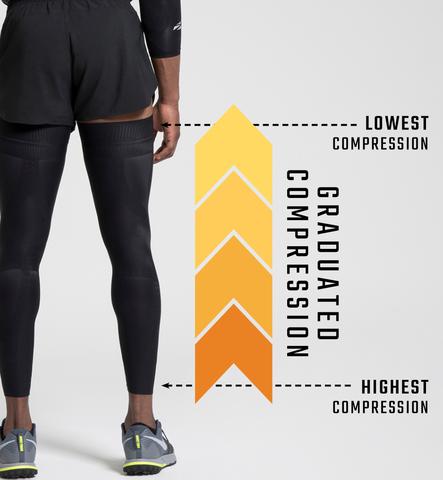It may be difficult to believe but doing something as simple as changing your footwear can completely alter your quality of life for the better. Compression socks are one of those utilitarian articles of clothing that does this best. Normally, when it comes to footwear, we’re concerned with how it looks and performs. We don’t typically think of it in terms of medical or quality of life benefits, but that’s the entire point of compression socks. Yes, they look good and feel comfortable, but they also make just being on your feet better. Like most amazing footwear, compression socks come in a wide variety of different types. Each type, like extra wide kind, has its own associated strengths and weaknesses that makes them suitable for the right person.
What Are Extra Wide Compression Socks?
Extra wide compression socks are the perfect solution for the athletic or physically active person, especially someone involved in activities that require a powerful lower body. Unlike some other compression sock styles, compression socks for wide feet are designed to suit a large calf and wide foot, two common physical traits of athletes. Even if you have great arches and somewhat narrow feet, your foot will still expand when you press down on it; the more pressure placed on it, the wider it spreads out. Extra wide compression socks will give you all the benefits compression socks have to offer without you having to sacrifice your comfort or reduce the compression sock’s effectiveness.

Benefits of Extra Wide Compression Socks
Compression socks come in a wide range of styles designed to accommodate an equally large range of body types and physical activity. Generally speaking, extra wide compression socks are designed to benefit a calf with a wide circumference. This normally means the calf is a minimum of 18 inches around for men and 14 inches around for women.
Like all compression socks, extra wide compression socks are a tool for carrying out compression therapy. Which mostly focuses on applying pressure to your legs or arms as a means of regulating blood flow from your limbs to your heart. They also reduce pain and swelling in your lower body,
Some other common benefits of compression socks are there ability to:
- Support veins
- Boost blood circulation in the leg
- Counteract vasovagal syncope – blood pooling in the leg
- Reduce orthostatic hypertension – causes dizziness when a person stands up
- Reduce the pain caused by varicose veins
- Improve the drainage of the lymph nodes
- Lower leg swelling
- Prevent venous ulcers from developing
- Reverse venous hypertension

Who Should Use Extra Wide Compression Socks?
Just about everybody can benefit from using compression socks on a regular basis. Not only do they help with a wide range of medical conditions, but they also shorten your recovery time from physical exertion. They prevent the swelling and pain that you’re likely to feel at the end of a long day from standing on your feet. There are two criteria for choosing to invest in a pair of wide compression socks:
- You have a large calf or wide foot.
- You are physically active.
Any person that meets both criteria will find some benefit from utilizing extra wide compression socks. But people who don’t have naturally large calves can also make great use of extra wide compression socks.
Pregnant Women
Pregnancy is one of the more physically burdensome conditions to deal with. Not only does a pregnant woman put on an excess amount of weight that she may not be used to, but her blood circulation becomes an issue. Walking and working can become an issue later into the pregnancy, along with other associated conditions, such as swelling in the feet, lower legs, and ankles. Fatigue caused by over exertion and lack of efficient blood circulation also becomes a problem. Extra wide compression socks can help to treat these conditions via compression therapy without making the expecting mother feel uncomfortable by being too small.
Overweight People
Being overweight creates a burden on your
body and causes some pretty unwanted symptoms that can degrade your quality of
life overtime. One of the worst symptoms is the swelling of the legs. When your
legs swell it can cause a great amount of discomfort and interfere with other
aspects of your life, such as getting a good night’s risk. If left untreated,
this can lead to the development of chronic conditions or make preexisting ones
worst.
People Who Feel Constantly Cold
It is never fun to have to deal with feeling
constantly cold, especially if the weather is already not very pleasant. Poor
blood circulation can easily cause a person’s body temperature to plummet.
Compression socks not only keep a person warm because they themselves are warm
and fuzzy, but they drastically improve blood circulation which keeps the body’s
temperature high.
Popular Articles on ComproGear
Compression Socks for Nurses Support Stockings for Nurses
Best Compression Socks for Sitting All Day How To Prevent Leg Swelling While Sitting
Rose Toy Rose Sex Toy
Best Compression Socks for Elderly Old Man Compression Socks
Compression Socks for Men Male Compression Socks
Penis Straws Penis Bachelorette Party Decor
Car Air Purifier Auto Air Purifier
Athletic Conditions that Compression Socks Can Help With
Athletes are another group of people that greatly benefit from wearing compression socks, especially while they’re competing or practicing. As previously mentioned, compression socks help a person to improve blood circulation. This doesn’t just help a person warm up inside; it also helps people to recover from strain and stress faster, which can help an athlete recuperate at a faster rate between workouts. Lactic acid buildup is another common problem that many athletes face, especially if they do anaerobic activity. It can cause your muscles and your body to cramp up, and become stiff and sore overtime. Compression socks help to expel lactic acid buildup faster which improves athletic recovery time.

The increased blood circulation that compression socks facilitate can also improve an athlete’s overall performance. Your blood supply carries oxygen to your vital organs like your lungs, heart, and brain which every athlete needs to be functioning at optimal capacity to achieve success. Wearing compression socks during your workout will improve your breathing, lower your heart rate, and improve your focus, three things that give your body an edge during physical competition.
Compression socks don’t just help with performance and recovery either; they also help to prevent injuries from occurring. Athletic grade compression socks help to compress the muscles in your legs and feet to reduce the vibrations that travel through your body. Impact vibrations cause massive wear and tear that will eventually lead to injuries. The vibrations also make athletes and people more susceptible to receiving reoccurring injuries or causing preexisting injuries to act up. And you don’t have to be an athlete for this to be a problem. Concrete and asphalt are high impact surfaces that can cause strain over time, no matter how little physical exertion you normally do. Simply walking a mile every day on concrete is enough to develop some form of chronic pain over time.
How to Measure for Extra Wide Compression Socks
Choosing the correct compression socks starts with choosing the right size for yourself. When it comes to the wide world of compression socks, this means you have to take two factors into account: the size of your feet and legs, and the size of the socks. The former is a matter of measuring yourself properly, while the latter requires a little bit of industry knowledge. Different companies have different sizes; a medium for one compression sock band may be a small or a large in another.

Prep for Measuring
Before you start measuring yourself for your future pair of amazing compression socks, it is important to take a few considerations into account.
- The style of compression sock
Compression socks typically come in several different styles that vary depending on how high they go up your leg. The standard styles are knee high, thigh high, and panty hose. The styles pretty much speak for themselves and tell you how high you need to be prepared to measure to get the optimum fit. A knee high compression sock will require you to measure from the floor to the knee for example.
- Equipment
All of your measurements can be completed by using a flexible measuring tape. A flexible tape, like that used by a tailor is necessary because you need to figure out the circumference of your legs. Accuracy is very important when trying to figure out your compression sock size. Remember, this is a piece of medical equipment, so the less precise you are, the less effective the equipment will be. If you do not have a flexible measuring tape on hand, then use a piece of string. Simply complete all your measurements with a string, then measure the string using a normal ruler. - Time of day
You may have already noticed, but your body subtly changes sizes throughout the day. This mostly happens due to bloating or swelling caused by activity and eating. You want your measurements to be for your default size before swelling or inflammation changes the size of your legs. For most people, the best time to achieve this is early in the morning before they become physically active.
The Measuring Procedure
No matter which style of compression sock you’re looking into, the measuring process is more or less the same. The style really only tells you how far from the base off the floor to measure up.
- Measure around your ankle
You always want to start by measuring the ankle at the narrowest point, which is just above the ankle bone – that’s the part of your ankle that is typically exposed when in a standard shoe. - Measure around the widest part of your calf
This measurement is extremely important for people looking to buy extra wide compression socks. It is the hardest measurement to match for some people, and depending on its size, you may have to purchase a specialty compression sock. Make sure to place the tape at the part of the calf that sticks out the furthest, right before it begins to taper back into the leg.
For thigh high socks you will have to measure the circumference of your thigh at its widest part as well. - Measure from the floor to the top of where the sock should end
This measurement varies depending on the style of sock you’re planning on purchasing. If you are looking for the standard knee length sock, measure from the floor to the bend behind your knee. The most accurate way to achieve this is to sit down and bend your knee at a 90-degree angle. Then measure from the ground to the bend in your knee.
For thigh high socks or stockings, measure from the floor to the bottom of your buttocks.
After you have all of your measurements, the next important step is to compare your measurements to the sizing chart of the particular manufacturer. Also, remember that there is a chance that your measurements will change if you gain or lose weight, or if you put on muscle. If you do change weight, take the time to measure yourself again so as to avoid buying the wrong pair of socks.
Choosing the Right Compression Level
After you know your measurements, it is time to choose your appropriate compression level, the amount of pressure that the socks will apply to your legs. Compression socks come in multiple compression levels, and each level serves a different purpose. Levels are measured in terms of millimeters of mercury (mmHg). The larger the compression measurement is, the higher the compression the sock will exert on your legs.

The best way to choose your compression level is to consult with your doctor as they have a better idea of what your body needs and how compression therapy can treat your condition. But there are some general traits associated with each compression level, so you can make a pretty good decision on your own.
8-15 mmHg
This is the lightest compression level; most
people won’t even notice they’re wearing compression socks at this level. These
socks are best for dealing with minor swelling and providing relief for tired
or tender legs. They also help to reduce swelling by lightly increasing
circulation.
15-20 mmHg
This level of compression is best for dealing
with minor to moderate levels of swelling, soreness, varicose veins, etc. This
is the type of discomfort caused by sitting or standing for long periods of
time. People who are not highly physically active but have an excess amount of
weight or strain on their body will benefit the most from these, such as
pregnant women or students with overburdened backpacks.
20-30 mmHg
This is most popular compression level that
is most often prescribed by doctors. It is amazing for providing relief from
deep pain or discomfort caused by a moderate to very active lifestyle. It is
commonly referred to as Class I compression.
30-40 mmHg
This level is often called, Class II
compression, and is normally prescribed to provide relief for specific medical
conditions such as varicose veins, sever edema, or deep vein thrombosis. You
should not use this level of compression without a doctor’s supervision.
Side Effects of Wearing Extra Wide Compression Socks Incorrectly
The reason that it is so important to make sure you’re properly measuring yourself and choosing the correction compression levels is because there are consequences to wearing compression socks incorrectly. It’s not going to kill you to wear the wrong pair of socks, but it will defeat the purpose and possibly result in some unpleasant backlash. If you wouldn’t take prescribed medication incorrectly, then you shouldn’t wear your socks incorrectly either. Some common symptoms that come from wearing the incorrect socks are:
Discomfort
Discomfort in the feet and legs is one of the
primary signs that you’re wearing the wrong pair of socks. If you feel pain
after removing your socks or pain in your legs while wearing them, you need to
either remeasure yourself or consider using a lower compression level. This
also happens if you wear your socks for too long. They should only be worn
during the day while you are active; make sure to take them off at night before
going to bed.
Corns and calluses
When compression socks are too tight you may
begin to develop calluses or corns. Your body develops corns and calluses as a
means of protecting itself against outside friction and pressure. They normally
develop on the feet and toes but can appear elsewhere. Calluses and corns are
surefire signs that you may have too high a compression level.
Toe spasms
This is a bit of a strange symptom, but it
does happen. If your socks are too tight you may experience sudden and
involuntary contractions of muscles in your toes. These contractions are
normally accompanied by pain and loss or interference in normal functionality.
This happens when you’re not getting enough blood flow and is a sign that you
need a properly fitted pair of socks. It is not always a sign that your
compression levels are too high either.
Compression socks work according to a concept of graduated compression. This
means that the most pressure should be around the ankle, and it should lessen
as the sock extends towards the knee. If you measured your ankles or length of
sock incorrectly, you may begin to experience toe spasms.
Joint pain in knees
Compression socks are supposed to help
provide joint pain relief, so you know that something is very wrong if they are
instead causing you to experience joint pain. If your joint pain intensifies
after wearing compression socks, it is a sure sign that you’re wearing the
wrong size. Either measure yourself again or consult a doctor right away if
this happens.
Loss of circulation
Once again, compression socks are supposed to
help with blood circulation, not make it worst. If you experience bad blood
circulation after putting on compression socks (this is typically defined by
your leg falling asleep -that pins and needles feeling you experience when
sitting down for too long), then you should remove them immediately. It is time
to measure again and consult a doctor to make sure that you are physically
healthy enough to wear compression socks.
When to Replace Your Plus Size Compression
Stockings
For the most part, you want to treat your
compression socks like any other pair of socks and replace them when they
become too battered, holey, or smelly. Basically, when the socks become
unpleasant to have on your feet or clash with your style, it is time to replace
them. But don’t forget, that these socks are also medical equipment, so you
need to take in an extra consideration. Compression socks are just socks if
they aren’t functioning properly. It is important that you constantly inspect
your compression socks to make sure that they are able to compress. Check the
elastic and make sure that the socks feel tight against your skin and muscles.
This is one of the reasons why it is important to have more than one pair of compression socks, especially if you’re using them for athletics. The more often you wear them, the faster they will deteriorate and lose functionality. And sweating in them only serves to make them deteriorate even faster. The best way to prolong the lifespan of your compression socks is to constantly rotate between pairs; this will cut down on the amount of washing each pair experiences and keep them in rotation longer.
Conclusion
Compression socks are amazing. They are a simple device that can literally change your life for the better. Unlike other types of medical equipment, they don’t take any training or truly specialized knowledge to utilize; it’s one of the reasons they’re so great. The extra wide compression socks just make these wonderful medical devices more accessible to a wider range of body types. Although the concept is pretty simple overall, make sure to ask your doctor if you have any questions or concerns.
